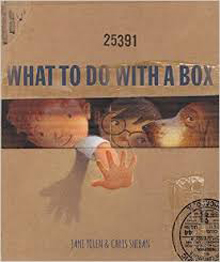 What to Do with a Box. Jane Yolen. Ill. Chris Sheban. 2016. Creative Editions.
What to Do with a Box. Jane Yolen. Ill. Chris Sheban. 2016. Creative Editions.
Ages: 4–8
Summary
Jane Yolen’s What to Do With a Box ignites readers’ imaginations as they enter a world of make-believe by exploring what can become of a cardboard box. Enhanced with textured and cardboard-like art, the power of play and imagination are simply stated, a box can become a sailboat, race car, the setting of a story, an imaginary place for play, or a magical adventure. Educators can use this book as a mentor text to introduce design thinking and making through literacy for young children. With a little creativity in our minds, and the work of our hands, a cardboard box can become anything we design and imagine it to be!
Cross-Curricular Connections: Language arts, science, math, and social studies
Ideas for Classroom Use
Ideation/Brainstorm
Ignite children’s imaginations and creativity by encouraging them to make connections with the world around them. After reading What to Do With a Box, discuss where ideas come from. Discuss the influence of background knowledge and how previous experiences help formulate ideas. Discuss the process of coming up with an idea. Ask students to think about what they would make from a cardboard box. Have students draw their idea, write about their idea in an “invention journal,” or both. Allowing time and space for students to explore ideas they have will help them to create authentic ideas. Have students explain their ideas to peers in small groups. Encourage students to provide positive feedback and suggestions for each idea presented.
Introduce the Design Thinking Process
The purpose of this activity is to explore the concept of design thinking (discovery, interpretation, ideation, experimentation, test). Discuss with students how to approach a challenge (making/creating something), how to interpret their ideas using materials, and how to go about making their idea come to life.
Publish/Produce
When students are finished with their creation, record on video students telling the story behind their creation. Allow time for students to engage in and use imaginative play with their final product/creations. Children can also create a book (digital or low-tech) that tells the story of their design process.
Reflect on the process of design thinking and making. Ask students to revisit their drawing, writing, or both, in the ideation stage and compare their idea to the actual product. How did it stay the same? How is it different? Students can write in their invention journal to compare their original idea to their final product. Discuss students’ cardboard creations in relation to the cardboard creations in the text What to Do With a Box, drawing upon similarities and differences.
Scientific Creations
Engage children in a cardboard challenge to make a creation out of cardboard that aligns with your curriculum. Using What to Do With a Box to foster ideas, children can make a futuristic vehicle, boat, aircraft, or drone. Other ideas include study scientists and the processes of discovery. Ask students to take an existing invention and improve upon it—using cardboard.
Building Around the World
Just like the children in What to Do With a Box, students can learn about palaces around the world and create one on their own using cardboard. Children can also explore cultures and geography around the world and design their own place using cardboard. Extend these activities by exploring books and engaging children in writing about their creations. Examples may be to create a website or brochure for their imaginary place.
Additional Resources and Activities
Ask students what careers they know about that use design thinking. Talk about and define engineering, scientists, mathematics, architecture, and authors. You can start by talking about how each “designer” uses the design process to make something. For example, how does an author design a story? How does an engineer design a building, car, or house?
To learn more about design thinking and creative processes in classroom spaces, visit IDEO’s website for educators.
Explore Jane Yolen’s website to find out more information about her, writers’ workshop resources, book trailers, and other books she has written.
Connect making with cardboard to science, math, social studies, art, and literacy with ideas from Kids Activities Blog.
Keep up and explore what is happening in the maker world at Makerspaces.com through Twitter.
Additional Literature With Similar Themes
The Most Magnificent Thing. Ashley Spires. 2014. Kids Can.
Not a Box. Antoinette Portis. 2006. HarperCollins.
Not a Stick. Antoinette Portis. 2007. HarperCollins.
What Do You Do With an Idea? 2014. Kobi Yamada. Compendium.
 Christiane Wood is an assistant professor at California State University San Marcos, where she teaches literacy theory and methods courses.
Christiane Wood is an assistant professor at California State University San Marcos, where she teaches literacy theory and methods courses.